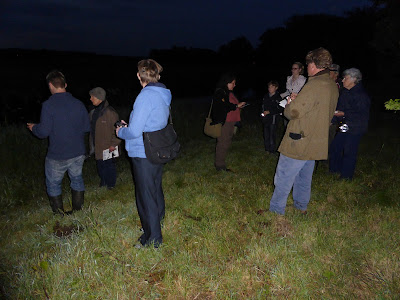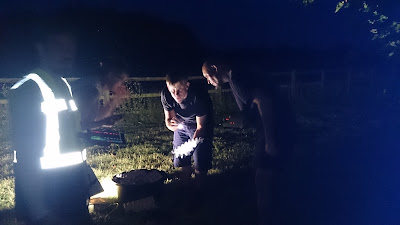 |
| Another event! Our first Bat Blitz event on Saturday August 15th 2015. Do join us if you can. |
Heritage Lottery Fund

Wednesday, 15 July 2015
Common Pipistrelle
 |
|
Common pipistrelle on rock (© Rosie Corner /
Bat Conservation Trust)
|
A widespread species of bat, the common pipistrelle (Pipistrellus pygmaeus) is distributed
throughout UK. It is a generalist species and can be found in a wide variety of
habitats, including urban and suburban environments such as parks, gardens and
around street lamps.
The common pipistrelle is a small, brown bat with triangular ears. It
has a dark face, (almost black) with black ears. It has a two toned fur; black
rooted and brown outer. Like the Soprano Pipistrelle, the common pipistrelle
weight is normally around 3 – 8g (the weight of a two pence coin). Maternity
colonies are formed from May and young are born around June/July (1 pup to each
female). The neonates (newborns) can weigh 3.3g in 10 days, 4.1 g in 20 days, are
independent at 4 weeks and foraging by themselves in 6 weeks. By the end of their
first autumn young female bats will have reached sexual maturity.
Calls of the common pipistrelle can be picked up on a heterodyne detector between 45kHz – 70kHz.
The calls sounds like a series of clicks and wet slaps and at the peak
frequency of 45kHz, the deepest, clearest calls can be heard. In general most
calls made by bats are normally above our hearing range. However, young
children and adults with exceptionally good hearing can hear the ‘chonk’
sounding social calls made by pipistrelles (around 22kHz), without the aid of a
detector. |
| On a sonogram, the shape of a pipistrelle call is a distinctive ‘hook’ or ‘hockey stick’.A common pipistrelle recorded on an Echo Meter touch outside All Saints Church, Besthorpe on the 4th July 2015 |
Emergence time for a common pipistrelle is around 20 minutes after sunset. It flies and forages about 2 – 10m above ground, ducking and diving and catching its prey on
the wing. It eats mainly flies (Diptera) and occasionally midges and mosquitos.
Its distinctive jerky, fast and erratic flight is easily recognised. In fact it is the bat you are most likely to
see when out in your garden at dusk.
Common pipistrelles are a synanthropic species (closely associated with
humans). Both their summer and winter roosts are located on the outside of
buildings under wall claddings, cavity walls, eaves and roof coverings. Occasionally
they will also roost in trees and bat boxes. Females are less loyal to their roost
compared to other species of bats. They have been known to move their maternity
colonies every 12 days. Though populations are stabilising, due to their
dependence on our buildings, pipistrelles are still very vulnerable to changes
such a building renovations and timber treatments.
Monday, 6 July 2015
A nocturnal walk along the Wensum Way
Our next walk saw us visiting the lovely All Saints Church
in Swanton Morley on Saturday 20th of June 2015. Built in the 1300s,
All Saints is a grade I listed building, located close to the Wensum Way. It has
had a long history with bats, with a maternity colony of Natterer’s bats using
the building, and has been involved with recent research looking into ways to
implement techniques, that will provide a solution for churches affected by
large bat colonies, without causing undue harm to the resident bats.
At 21.00, we welcomed 7 people plus 2 volunteers, Laura and
Jamie. As the sun began to set, we headed down to the Wensum Way, a Norfolk
County Council Trail, aptly called the ‘River Walk’ by the locals. Taking us
into a beautiful Norfolk landscape consisting of open pastureland, hedgerows,
and fragmented woodland, it looked like promising territory for our walk.
Around 10 minutes into the walk, we heard our first bat, a
Noctule. Looking up we saw 2 Noctules flying above our heads (Noctule prefers
to fly in straight lines high up above the tree line, over open habitat),
followed shortly by a few others. Seeing these many Noctules, indicated to us
that their roost was probably nearby. Noctules tend to roost in trees,
particularly ones that have old woodpecker holes. We then heard our first
pipistrelle, a Soprano Pipistrelle, one of our smallest bats weighing between
4- 7g.
 |
| Learning how to use a bat detector © Norfolk Wild Nights, Sonia Reveley |
Progressing towards the River Wensum, we looked back towards
the church and we were rewarded with a view of the sunset lighting up the sky with
flashes of red, yellows, and gold. This view was in stark contrast with the sight
we saw when we arrived at the side of the river, a darkening horizon and mist
rolling into the fields. It was here that we heard and saw our first Daubenton’s
bat, a Myotis species that prefers water habitats and is aptly nicknamed ‘the
water bat’. Having satisfied ourselves with listening to Daubenton’s and
Soprano Pipistrelles by the riverside, we started our journey back to the
church and heard our first Natterer’s, most likely part of the colony exiting
from the church. In addition, we also heard some Common Pipistrelles as they
flew along the hedgerows.
On arriving back to the church faced with the possibility of
getting caught up in the impending rainstorm, we quickly checked the moth trap
that we set up earlier. We found a Straw Dot, Small Magpie, Heart and Dart and
2 Dark Arches. Afterwards when packing up the equipment we also found an
Elephant Hawkmoth and a Figure of Eighty moth.
 |
| Moth trapping © Norfolk Wild Nights, Sonia Reveley |
Thank you all for coming along. Your support for the project
has been much appreciated.
Subscribe to:
Comments (Atom)





